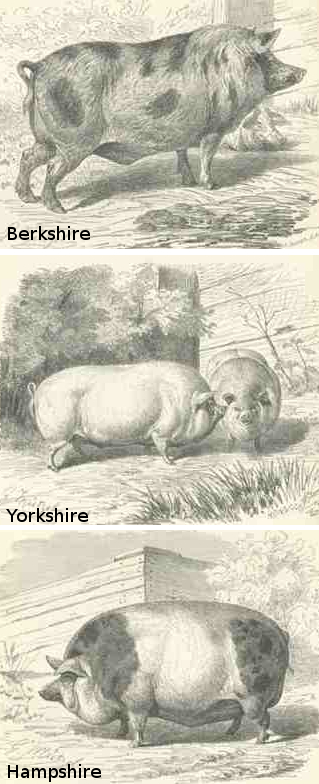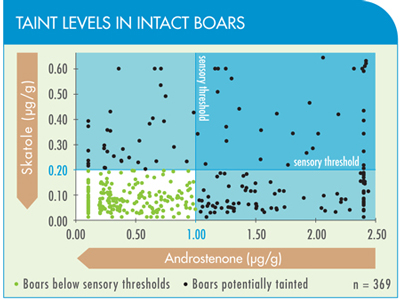
Choosing a feeder pig
 If you decide to finish
a hog or two for your table, your
first big choice is what kind of pig(s) to bring home. Most
sources suggest starting with two animals since pigs are sociable, but
you'll still need to make decisions about breed, sex, and various
medical procedures. Let's start with breed.
If you decide to finish
a hog or two for your table, your
first big choice is what kind of pig(s) to bring home. Most
sources suggest starting with two animals since pigs are sociable, but
you'll still need to make decisions about breed, sex, and various
medical procedures. Let's start with breed.
Commercial pigs are
generally pure or crossed Duroc, Hampshire, and
Yorkshire hogs, but small producers would be hard-pressed to maintain a
commercial-style hybrid without keeping two separate parent lines
going.
Klober considers purebreds best for small farmers keeping homegrown
herds, but my limited research elsewhere suggests that pastured pork
producers
often work with a single hybrid herd. For example, Walter
Jeffries' hogs are primarily a mixture of Yorkshire,
Hampshire, Berkshire, and Tamworth, while a producer local to us is
mixing Yorkshire, Hamphsire, Berkshire, and Duroc.
In general,
colored breeds may grow faster, taste better, and handle the outdoors
better in cold, damp weather, while white breeds are better mothers,
are
more docile, and do better in heat. Another factor to consider is
that fat flecks in the meat of
Duroc and Berkshire hogs are supposed to provide particularly good
flavor. But chances are, if you're just buying feeder pigs,
you'll
take whatever's available.
How about choosing
between gilts (girls) and boars (boys)? Gilts
are reputed to grow a bit slower, and to end up fatter (according to
Jeffries and our local producer) or leaner (according to Klober, who
raises his gilts on high-protein rations to speed their growth).
With barrows, the tricky question is whether or not to castrate the
pigs --- most sources recommend castrating boars (in which case they
become barrows) to prevent a bad taste in the meat known as boar
taint. However, Walter Jeffries believes boar taint is mostly a
myth and is only found in certain breeds, which don't include the ones
he raises. If you don't want to castrate and don't want to risk
boar taint, gilts might be a good choice.
 While you're deciding whether
or not to castrate, you'll also need to
decide whether to dock tails and knock out wolf teeth. Both of
these
surgeries seem to be similar to clipping the beaks of chickens ---
confinement farmers do it so their animals don't kill each other when
packed close together, but non-confinement farmers usually skip
it. Similarly, you might get away without deworming your feeder
pigs if you're raising them in a rotational pasture arrangement.
(Organic alternatives to chemical dewormers include garlic and
diatomaceous earth.)
While you're deciding whether
or not to castrate, you'll also need to
decide whether to dock tails and knock out wolf teeth. Both of
these
surgeries seem to be similar to clipping the beaks of chickens ---
confinement farmers do it so their animals don't kill each other when
packed close together, but non-confinement farmers usually skip
it. Similarly, you might get away without deworming your feeder
pigs if you're raising them in a rotational pasture arrangement.
(Organic alternatives to chemical dewormers include garlic and
diatomaceous earth.)
The last factor to
consider when choosing your pigs is the environment
that they came from. If you plan to raise pigs on pasture, don't
buy them from heated nurseries. And, at the other extreme,
pastured pigs won't do as well in confinement.
I'd be curious to hear
from more experience pig-keepers out
there. Do you recommend gilts or boars? Do you
castrate? Any other tips for choosing a good pig for the
homestead?
| This post is part of our Storey's Guide to Raising Pigs lunchtime
series.
Read all of the entries: |
Want more in-depth information? Browse through our books.
Or explore more posts by date or by subject.
About us: Anna Hess and Mark Hamilton spent over a decade living self-sufficiently in the mountains of Virginia before moving north to start over from scratch in the foothills of Ohio. They've experimented with permaculture, no-till gardening, trailersteading, home-based microbusinesses and much more, writing about their adventures in both blogs and books.
Want to be notified when new comments are posted on this page? Click on the RSS button after you add a comment to subscribe to the comment feed, or simply check the box beside "email replies to me" while writing your comment.

DO remember..... if you happen to slip, and fall in the pen.....they will attack, kill, and eat you.
Safety is a prerequisite.
Edith
Thanks Edith,
I have heard that too, however, your comment made me really laugh. Now that I am second guessing raising pigs, it reminds me of petting my cats tummy. That is very dangerous as a well.
(I dont know if this went through the first time)
First off, sorry, terms are beyond me.
I raise 1 or 2 pigs every year, Ive been doing that since 08. I originally started with a one of each sex, with the male intact. Maybe at bit of a mistake because I ended up with 12 more pigs that year. I sorted it out and kept two boys to raise. One did start to get pretty aggressive around 4 months old. I eventually had to separate them, because the more aggressive guy wouldn't let the other eat or wallow in his mud.
Anyway I do a mixture two males or two females or one each every year. I keep them separate with fencing now days, no babies no fighting. I get them from the same guy each year, and he doesn't castrate, and I'm not up to it. I don't know what crosses they are, white with black butts, but I don't ever remember the meat being strong from them being intact.
Everyone is different but I have had a few males over the years get temperamental. I raise my pigs in a large corner space where I don't need to go into if I don't need to. But if they had more room or where roaming I would without a doubt get them castrated.
As for which Id go with male or female. I like males because they do grow a little faster, larger too, I like big hams. But Ive noticed over the years, being intact, the males don't put on the weight that the females do. And their feet don't taste as good for some reason. I label the meat when I put it in the freezer if it came from a m or f, because the girls are, um, more fatty. You know for cooking reasons its good to know.
You know for cooking reasons its good to know.
Any other tips! Yeah! Don't let them get a taste for your potatoes, both kinds!
I don't know if you want me to get into talking about feed.
So excited to see you two do this! I will be very interested in seeing how the project unfolds.
We buy pork from a local farmer's Berkshire hogs. It's the best tasting pork I ever had. It might be the best meat I ever had.
-Joe